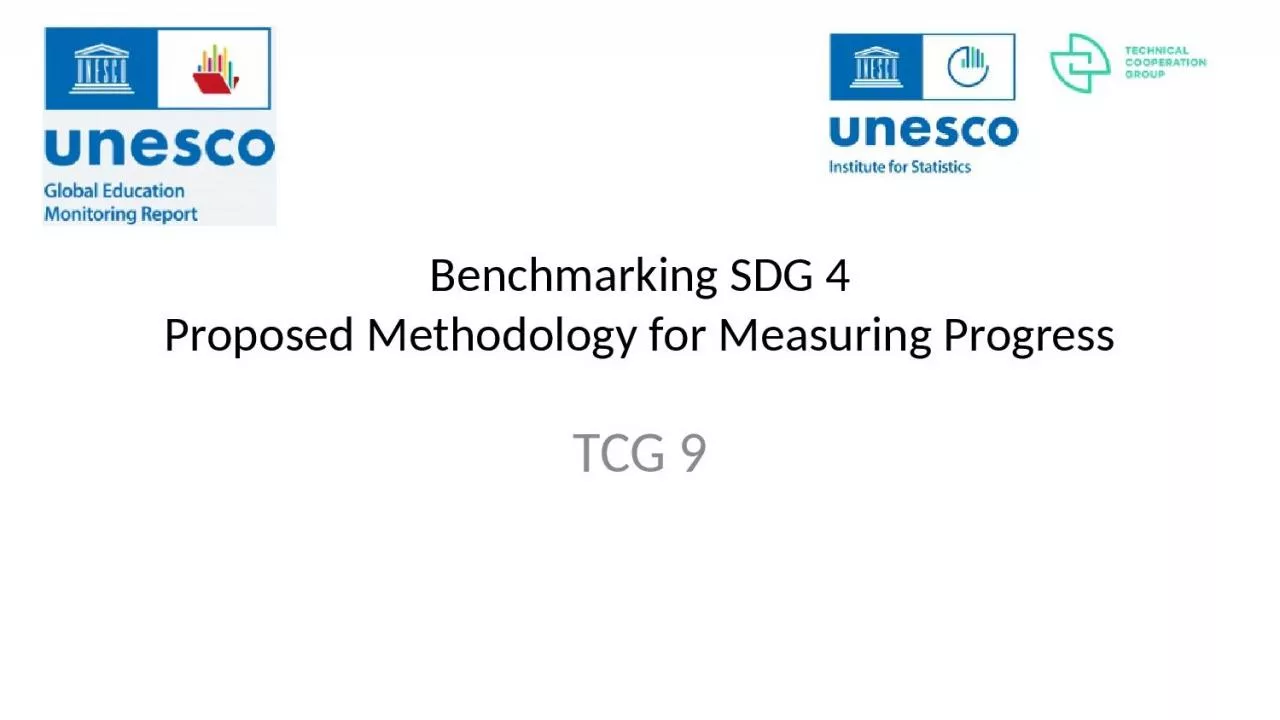

TCG 9 Background Education 2030 Framework for Action commitment to establish national benchmarks for SDG 4 as part of strengthening accountability for SDG 4 and GEMR and UIS to support countries ID: 1027665
Download Presentation The PPT/PDF document "Benchmarking SDG 4 Proposed Methodology ..." is the property of its rightful owner. Permission is granted to download and print the materials on this web site for personal, non-commercial use only, and to display it on your personal computer provided you do not modify the materials and that you retain all copyright notices contained in the materials. By downloading content from our website, you accept the terms of this agreement.
1. Benchmarking SDG 4Proposed Methodology for Measuring ProgressTCG 9
2. BackgroundEducation 2030 Framework for Action: commitment to establish national benchmarks for SDG 4 as part of strengthening accountability for SDG 4 and GEMR and UIS to support countriesAugust 2019: TCG endorsed seven indicators selected for benchmarking August 2021: Invitation to member countries to set benchmarks for 2025 and 2030February 2022: Invitation to revise benchmarks following release of initial results, particularly for countries that did not share benchmarks
3. Methods proposed to benchmark progressObjective: Given that countries have established national benchmarks, the objective of the proposed methodology is to benchmark recent progress made for each indicatorUnderlying principle: use historical rates of progress for an indicator defined by 25th and 75th percentile of progress rates observed historically (2000 to 2015) to help benchmark recent progress (observed since 2015)Two methods proposed for each indicator (except expenditure):Method 1: benchmark each country’s recent progress (since 2015) based on historical rates of progressMethod 2: benchmark the rate of progress needed to achieve national benchmarks based a country’s current level and on historical rates of progress, i.e.: how far from the national benchmark is the country now?One method for public expenditure indicators: use the international benchmarks for public expenditure as a percent of GDP (4 percent) and of total government expenditure (15 percent)
4. ProgressCategorizationDefinitionNo dataNo data for indicatorNo trendOnly one data pointRegressionDecline in indicator recentlySlowRecent progress was less than the historical 25th percentileMediumRecent progress was between the historical 25th and 75th percentilesFastRecent progress was above the historical 75th percentile (or within 5 percentage points of 100%)ProgressCategorizationDefinitionNo dataNo data for indicatorNo trendOnly one data pointNo national benchmarkCountry has not established or shared a national benchmarkRegressionDecline in indicator recentlySlowFar from national benchmark, needs progress above the historical 75th percentileMediumClose to national benchmark, needs progress between the historical 25th and 75th percentilesFastVery close to national benchmark, needs progress below the historical 25th percentileMethod 1Method 2Categorizing recent progress
5. Method 3: for public expenditure indicatorsCategorizationDefinitionNo dataData is missing for either public education expenditure as a percent of GDP or as a percent of total government expenditureAchieverAchieves international benchmarks for both indicatorsPartial achieverAchieves international benchmarks for one of the two indicatorsNon-achieverDoes not achieve international benchmarks for either of the indicatorsCategorization based on whether public expenditure as a percent of GDP exceeds the international benchmark of 4 percent and on whether public expenditure as a percent of total government expenditure exceeds the international benchmark of 15 percent